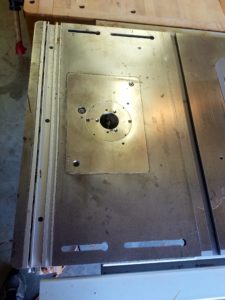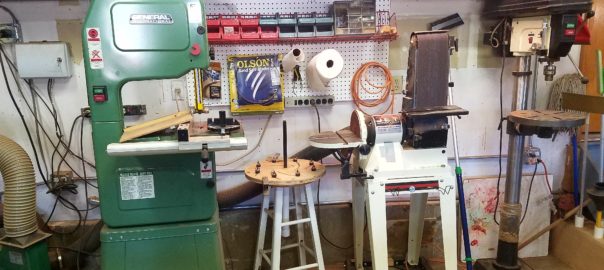Ten Essential Power Tools For Your Shop
In my case, the first three power tools I had were an electric drill, an electric skill saw, and an electric jig saw. I inherited these from Dad almost 50 years ago. These are the only power tools I had when I finished the basement in my first house and built the deck in the back yard. Later I made a coffee table and some deck chairs. I still have these tools and they work just fine.
I don’t think power tools are made the same way today that they made them years ago. When my Dad walked into Sears to buy an electric drill he didn’t have many choices. They didn’t sell cheep ones, medium priced ones and top of the line drills, they simply sold electric drills that were designed to last, and this brings me to my first point:
Buy Power Tools That Will last a Lifetime. When I asked several experienced woodworkers what tools they most regretted buying, the more interesting answers were: The cheep one or the small one. This is why most of the used tools for sale are the cheap ones and the small ones.
I made this mistake myself more than once. The first lathe I purchased was the cheapest one I could find. I won’t name the brand, but it wasn’t long before I found that the jumping, shaking and wobbling was frustrating and ruining a lot of my work. I only had that lathe about a year before I sold on Craigslist and bought Powermatic.
I also asked these woodworkers what the first power tools a beginner should buy are. Not surprisingly, I got different opinions from everyone. The following list was compiled from the responses I got from other woodworkers, books and internet searches and my own experience. The 10 tools are grouped into 5 handheld power tools and 5 larger tools that set on the floor or workbench bench, I called these stationary power tools. All of these tools are listed in the order that many woodworkers purchase them, not necessarily in order of importance; if there is such a thing.
STATIONARY POWER TOOLS
1. Compound Miter Saw
This is a very handy tool to have in the shop and often one of the first ones purchased. A good one can quickly cut boards to length, and precise angles both vertically and horizontally.
Understand that there is a difference between a miter saw and a compound miter saw. A compound miter saw can create bevel cuts. This is when the blade can tilt rather than remaining perpendicular. Where-as a miter saw will only cut with the blade angle at 90 degrees to the wood. So, when considering your purchase be sure to look for a good saw that cuts vertical angles as well as horizontal angles.
2. Drill Press
No complete shop should be without a drill press. It’s a necessity to drill accurate holes for making jigs and joints that use holes parallel to an edge. A drill press will also drill screw holes and countersink them.
3. Cabinet Saw
I know that I am going to get pushback on this as many wood workers argue that a portable table saw is the better choice because it is portable. On the other hand, we are talking about equipping a workshop, not a contractor’s work site. Here are a few reasons why cabinet saws are a better choice for the shop:

a) Power: Cabinet saws are topically 3 to 5 HP vs the contractor saw which is 1.5 HP, and usually can run on 120 v.
b) More Stable: Good cabinet saws weigh around 600 pounds with solid and sturdy cabinets that make them much more stable.
c) Blade Adjustments. The pivot points or trunnions, for the blades are heavier and stronger. They are also mounted on the cabinet not the table. This makes it much easier to adjust the blades and get them true.
d) Dust Collection: A major problem in all shops is dust. We go to great lengths and expense to keep it clean. With cabinet saws most of the dust is collected in the enclosed cabinet.
e) Attachments: One of my favorite attachments is the router table. My router table is attached to the saw which saves space in the shop and also males the saw’s table bigger. A bigger table is really nice when cutting large pieces of wood.

4. Router Table with Router
A router is the most versatile tool in the world; there is almost nothing it can’t do. When attached to a router table it becomes even more versatile. Here are just a few of the many things it can do: Cut grooves and inlays, decorative flutings, and trim wood flat. It will shape wood into circles, ovals, squares and more. It will cut mortises and tenons, dovetails, finger joints, rabbits and tongues.
The list can go on as far as your imagination will take it.
5. Band Saw or a Jointer?
Obviously, a jointer is no substitute for a band saw and a band saw cannot take the place of a jointer. The problem is, if we are going to list only five necessary tools then deciding between these two tools is very difficult.
For me, I would have to choose the band saw. The jointer only does one thing, it flattens one edge of a board. If you can’t flatten an edge, then it is almost impossible to join wood to make quality furniture, cutting boards etc. But unless you are going to make a lot of furniture or have the need to join boards for other projects, I would go with the Band saw first.
There are many woodworkers that would move the band saw right to the top of this list as the first machine you should buy because of it’s versatility. A band saw can rip boards to thickness, cut circles, curves and other shapes. The band saw is very handy for cutting for angles and joints. It will do it all with less dust and waste than the table saw.
HANDHELD POWER TOOLS
There’s not a lot of need to discuss these tools because many of them are already in most households. Even many no-woodworkers have them for doing work around the house.
1. Drill and driver
2. Skill Saw
I would recommend that if you need to purchase one of these that it use 110 v.. and not a battery. They use too much power for batteries to be of any real use.
3. Dremel or similar rotary tool
4. Jigsaw
5. Rotary Sander

